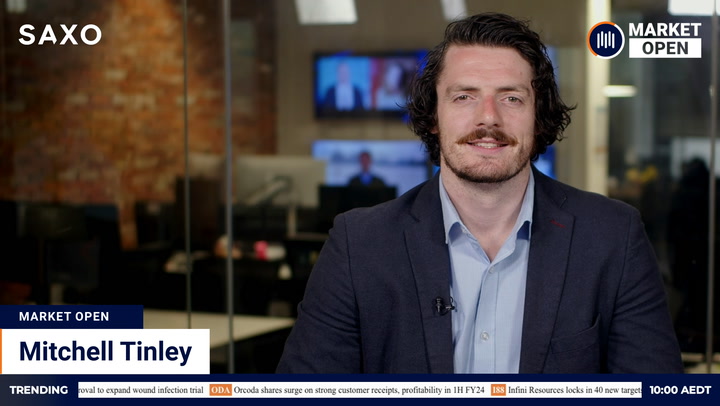Aussie shares had a third day of gains within reach after upbeat economic data and positive Covid news helped Wall Street heal from a recent omicron-fuelled sell-off.
ASX futures climbed 39 points or 0.54 per cent as US stocks rose for a second night.
Oil and most metals advanced. Iron ore declined. The dollar surged 1 per cent back above 72 US cents
Wall Street
US stocks continued to reverse a three-day slide triggered by rising Covid cases, the prospect of higher interest rates and fears a White House stimulus package had collapsed. The repair-work continued as economic data bolstered confidence in the recovery and after President Joe Biden outlined a plan to cope with the pandemic.
The S&P 500 rose 47 points or 1.02 per cent. The Dow Jones Industrial Average gained 261 points or 0.74 per cent. The Nasdaq Composite added 181 points or 1.18 per cent.
“For the first time seemingly since Thanksgiving, markets appear to finally be calming down as trading activity subsides ahead of the Christmas holiday,” Chris Hussey, a managing director at Goldman Sachs, told CNBC. “The triple headwinds of rising virus cases, a more hawkish Fed, and elusive fiscal stimulus are absorbed into risk-asset prices.”
A survey showed consumer confidence weathered the omicron outbreak. The Conference Board’s confidence index rallied to 115.8 this month from 111.9 in November. The survey was carried out during the early weeks of the month as the new Covid variant emerged.
“Consumers are bullish on 2022,” Robert Frick, corporate economist with Navy Federal Credit Union, told Reuters. “This is further evidence that consumer spending will keep rising and be the main factor fueling the expansion.”
Growth in gross domestic product during the September quarter was upwardly revised to 2.3 per cent from an initial reading of 2.1 per cent. A separate report showed existing home sales improved 1.9 per cent last month.
A South African study raised hopes the impact of the new strain was less severe than earlier variants. The study by SA’s National Institute for Communicable Diseases suggested omicron was less likely than delta to produce severe symptoms and lead to hospitalisation.
“Our data really suggest a positive story of a reduced severity of Omicron compared to other variants,” one of the study’s authors said. The study has not been peer-reviewed.
Adding to optimism was a sharp drop in cases in the South African province where the strain was first identified. The Gauteng province reported daily new cases declined from a peak almost 27,000 cases last week to 15,424 on Tuesday, raising hopes the outbreak has crested.
President Biden on Tuesday reassured Americans there would be no renewed lockdowns. The White House announced increased support for hospitals, better access to free testing and improved access to vaccination.
Separately, the US regulator granted emergency use authorisation for Pfizer’s Covid pill. The treatment is the first antiviral oral product approved for use.
Australian outlook
Cautious optimism has returned to financial markets. Risk assets rose overnight and defensive havens mostly declined.
The Australian dollar was on course for its highest close in more than a month. The Aussie, which tends to rise and fall with optimism about the global economy, charged 0.99 per cent to 72.18 US cents.
“The [US] dollar is softening as risk-off impulses continue to ebb,” analysts at Brown Brothers Harriman wrote.
The S&P/ASX 200 overcame early weakness yesterday to eke out a second gain. The index edged up ten points or 0.13 per cent to its best finish in more than a week.
A decent session today would bring the 7400 level into play for the first time since the initial omicron rebound started to falter. Thin holiday volumes may work in the market’s favour.
Today is the last full trading session before the four-day Christmas break. The market closes two hours early tomorrow at 2.10 pm AEDT (including closing auction).
All 11 US sectors rose overnight. A pause in a three-day rally in rates boosted growth stocks and bond proxies. The three sectors that house Big Tech gained between 0.78 and 1.73 per cent. Healthcare gained 1.17 per cent and real estate 0.95 per cent.
Gains in cyclicals were more restrained. Materials added 0.77 per cent, energy 0.57 per cent, financials 0.49 per cent and industrials 0.33 per cent.
IPOs: two listings today. Black Mountain Energy at 1 pm AEDT describes itself as an oil and gas explorer “bringing North American expertise to the Australian shale revolution”. Rubix Resources at 2 pm will explore for copper, nickel, PGEs, zinc and gold at four projects in Queensland and WA.
Commodities
Oil logged its highest finish in two weeks, supported by a drop in US inventories. The US Energy Information Administration reported US inventories declined by 4.7 million barrels last week.
Brent crude settled US$1.31 or 1.8 per cent ahead at US$75.29 a barrel. The close was the highest since December 8. The US benchmark, West Texas Intermediate, rose 2.3 per cent to its strongest settlement since November 24.
Gold regained US$1,800 an ounce in thin holiday trade as the US dollar receded. Metal for February delivery settled US$13.50 or 0.8 per cent higher at US$1,802.20 an ounce. The NYSE Arca Gold Bugs Index firmed 1.24 per cent.
“Gold prices are figuring out its year-end trading range somewhere around $1800 and that should remain intact as trading volumes decrease,” Edward Moya, senior market analyst at Oanda, wrote.
Industrial metals rallied after the UK opted against further pandemic restrictions. Zinc gained 3.3 per cent on the London Metal Exchange. Aluminium rose 2.8 per cent to its highest level in almost two months. Copper rose 0.8 per cent. In the US, copper rose 4.55 cents or 1 per cent to US$4.3915 a pound.
“Market players are looking at what the UK is doing and the fact that we haven’t seen any further COVID restrictions in the UK is a big relief,” Naeem Aslam, chief market analyst at Ava Trade, told Reuters.
“Also, we could see supply bottlenecks still being there in the first quarter of next year. That has made some traders making some bigger bets on that and also pushing prices higher.”
Iron ore retreated ahead of a seasonal slowdown in Chinese construction. Ore for May delivery fell 0.4 per cent on the Dalian Commodity Exchange to US$108.84 a tonne. The spot price for ore landed at Tianjin declined US$1.20 or 1 per cent to US$122.60.
BHP‘s US-listed stock fell 0.77 per cent. Its UK-listed stock shed 0.5 per cent. Rio Tinto gave up 0.18 per cent in the US and 0.99 per cent in the UK.







